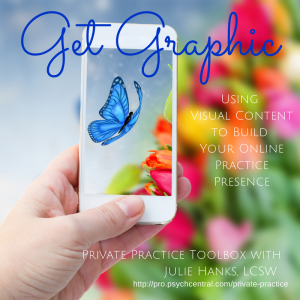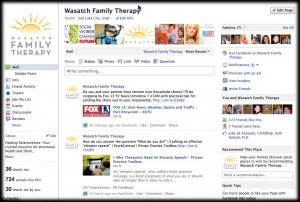 TV interviews are a great way to educate about relationship and mental health topics and to raise visibility for your private practice. Over the past few years, I've actively sought out interview opportunities and have found that over time, they have bolstered my credibility, fostered trust in my knowledge and clinical skills, and raised visibility of my private practice.
Thanks to social media, TV interviews can reach beyond the viewership of the live broadcast to a larger audience. One example is this short, live interview for a local Utah TV lifestyle program. "How To Handle A Narcissistic Mother" has had over 9000 views on YouTube (and yes, I'm still working on not saying ,"um").
TV interviews are a great way to educate about relationship and mental health topics and to raise visibility for your private practice. Over the past few years, I've actively sought out interview opportunities and have found that over time, they have bolstered my credibility, fostered trust in my knowledge and clinical skills, and raised visibility of my private practice.
Thanks to social media, TV interviews can reach beyond the viewership of the live broadcast to a larger audience. One example is this short, live interview for a local Utah TV lifestyle program. "How To Handle A Narcissistic Mother" has had over 9000 views on YouTube (and yes, I'm still working on not saying ,"um").
I reached out to other therapists to find out what they'd learned from their TV interview experience, what advice they'd give to therapists preparing for their first TV interview, and how these interviews have impacted their practice.
Here are 10 Tips to help you look and sound like an expert when TV interviews come your way.
1 - Do your homework
Find out who is interviewing you, how long the interview will be, and who watches the show so you can tailor your interview to fit the format and show yourself in your best light. Therapist Sharon Rivkin, MA, MFT and author of Breaking the Argument Cycle: How to Stop Fighting Without Therapy suggests researching the show's demographics, audience, and format so you can tailor the interview to the show's viewers. Before his local television news interview, Psychotherapist John Sovec, M.A., LMFT went online and found clips of the newscaster who'd be interviewing him to get familiar with his interview style.
2 - Develop talking points
From my own TV experience, mapping out 5-6 talking points is crucial to building my confidence, producers' confidence and interviewers appreciate the direction. Sovec adds, "The TV world moves fast and I always find that talking points help me to stay centered." Texas Psychologist Susan Fletcher, Ph.D., author of Working in the Smart Zone: Smart Strategies to be a Top Performer at Work and at Home found that "some TV anchors will stick to the talking points while others will veer off. Be prepared to go a little off topic and be flexible. You can always work your way back to the topic."
3 - Add visuals and examples
Fletcher suggests incorporating visual elements into your TV segments and shares this example: "One of the most visual segments I did was What to do on your Spring Break Staycation and I had visuals for everything you could do with your children. I've also used personal photos to show my points." According to Rivkin, giving specific examples to support your talking points makes interviews more compelling. She's learned through experience to "...be succinct, clear and direct. Give an example of a client you've worked with. Stories are more compelling and paint a clearer picture than descriptions."
4 - Prepare and practice
When preparing for a TV interview Terrence Alspaugh, LPCP, Psychotherapist of Family Solutions of Maryland wrote down and memorized talking points on index cards. "I practiced elaborating on each point with illustrations and examples. I wanted to be sure that I could say more about the points if time allowed." TV veteran Will Courtenay, PhD, LCSW, The Men's Doc always "over-prepares: for interviews and says he's always glad he did.
5 - Remember that you're the expert
If you're feeling a bit anxious about an upcoming TV interview David Simonsen M.S. LMFT of Creative Solutions Counseling suggests, "Remember that you are the expert and they are coming to you. Find comfort in the fact that you know your field and you have knowledge they don't."
6 - Speak in sound bites
A sound bite is a short phrase or a few phrases of information. Speaking in sound bites requires therapists to use skills that aren't often practiced. Good therapists often speak slowly, reflect back, pause often, and go deeper. However, good TV interview skills require the opposite: speak quickly, don't reflect back, keep the interview moving, and stay on target. For taped TV interviews, remember to pause at the end of each thought or phrase to allow for clean editing.
7 - Wear comfortable and flattering clothing
From my own TV experience, I find it's important to wear something comfortable that reflects my professional personality and my practice. If something you're wearing feels awkward or out of place it will detract your focus from the interview. Here are a few "what to wear" tips:
- Bright solid colors generally look better than prints or white.
- Wear colors that have elicited the most compliments in the past.
- Accessorize close to your face, drawing the eye upward.
- Wear more makeup than usual, even for men. "Wearing some foundation is especially important for men, who often have oily skin -- which will look shiny on screen -- and are more likely to sweat," Courtenay suggests.
8 - Look at the interviewer
Unless instructed otherwise, look at the interviewer. If the show is filming with several cameras, it can be confusing to track which camera to look at. For the record, the camera with the red light is the one currently filming. On her first TV interview Fletcher wasn't sure if she should look at a camera or at the interviewer after the interview was over. She says, "I was advised to continue looking at the TV host."
9 - Be yourself
Rivkin suggests, "Don't be afraid to be yourself and let your personality show. If appropriate, use humor. It can make the interview more interesting." Courtenay gives the following advice for therapists preparing for TV interviews, "Think of your interviewers as friends and remember they really are interested in talking with you. Try to achieve some intimacy, as if you're talking one-on-one to a friend. Don't worry about making mistakes, everyone does; if you misstate something, just simply repeat it."
10 - Don't Expect Immediate Results
Media Psychiatrist Carole Lieberman M.D. and author of Bad Girls: Why Men Love Them & How Good Girls Can Learn Their Secrets says:
Therapists often think that this will grow their practice, but unless you offer some very specific niche therapy that the public may not be familiar with, and patients with this need happen to see your appearance, it is not the most efficient way to get patients. I do not do it to grow my practice. In fact, TV appearances interfere with practice because you often have to reschedule patients at the last minute to do a TV show.
Of her TV interview experience Melody Brooke, MA, LPC, LMFT, author of Oh Wow This Changes Everything says that they haven't made a difference in her practice. "Its given me a lot of street credibility, but other than that, my practice has not grown at all." Courtenay adds, "Unfortunately, the impact of my TV appearances are hard to judge. However, many of my clients have told me that they've seen interviews with me before we met." Sovec says that he usually gets some calls after TV interviews but sees them as another step toward building public awareness about his work and to build his credibility as an expert.
In an upcoming post I'll share tips to maximize your TV exposure. Until then, watch and learn from these seasoned therapists' TV interviews.
Watch Dr. Will Courtenay
Watch Dr. Susan Fletcher
Dr. Carole Lieberman



 This year marks my 10th year in private practice and I've spent a lot of time reflecting on and blogging about what's contributed to the growth and longevity of my practice. As I started creating a timeline chronicling the evolution of my practice, it became clear that the growth of my private practice coincides with my online presence building efforts. I don't think it's an accident that when I began actively seeking media interviews, blogging, and building my social networks that my practice experienced tremendous growth.
This year marks my 10th year in private practice and I've spent a lot of time reflecting on and blogging about what's contributed to the growth and longevity of my practice. As I started creating a timeline chronicling the evolution of my practice, it became clear that the growth of my private practice coincides with my online presence building efforts. I don't think it's an accident that when I began actively seeking media interviews, blogging, and building my social networks that my practice experienced tremendous growth. TV interviews are a great way to educate about relationship and mental health topics and to raise visibility for your private practice. Over the past few years, I've actively sought out interview opportunities and have found that over time, they have bolstered my credibility, fostered trust in my knowledge and clinical skills, and raised visibility of
TV interviews are a great way to educate about relationship and mental health topics and to raise visibility for your private practice. Over the past few years, I've actively sought out interview opportunities and have found that over time, they have bolstered my credibility, fostered trust in my knowledge and clinical skills, and raised visibility of 
 You're in the mental health field because you want to make a difference and make a living, right? Technology and new media now allow therapists to educate and interact with worldwide audience and to talk directly to
You're in the mental health field because you want to make a difference and make a living, right? Technology and new media now allow therapists to educate and interact with worldwide audience and to talk directly to 
As healers, we genuinely like to do our work. Guiding clients through the therapy process and seeing them make progress is why we do what we do. But if you're in private practice, you know there's a lot going on in the back end and that it's crucial to run an efficient and organized business.